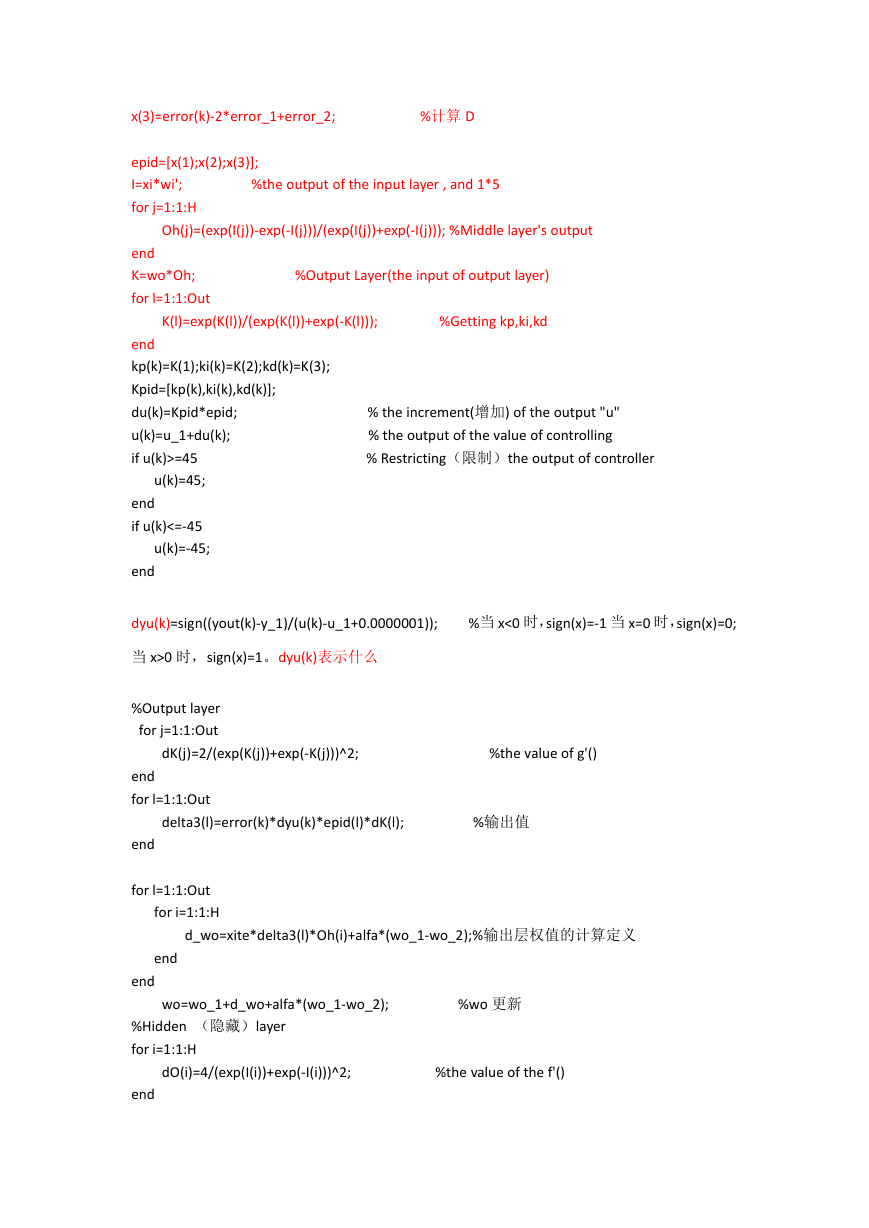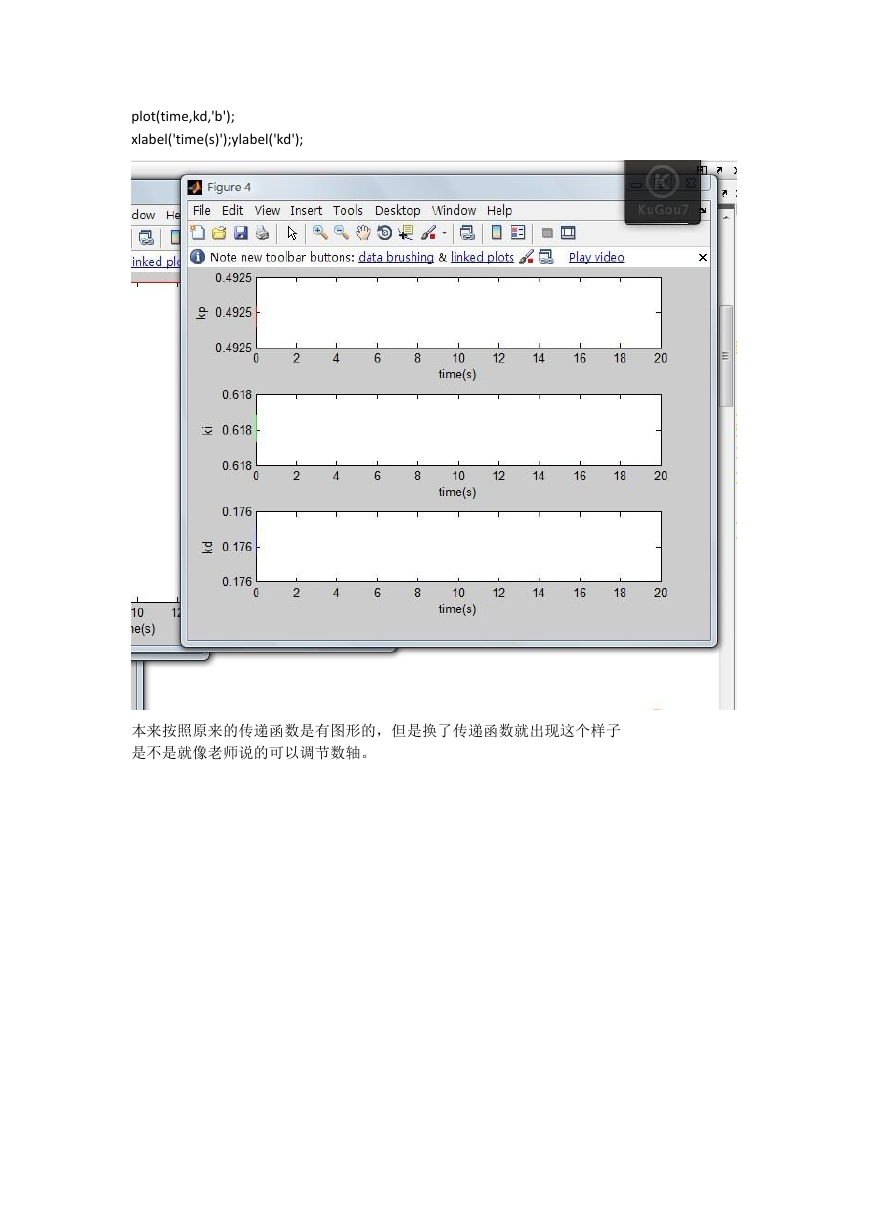%BP based PID Control
clear all;
close all;
xite=0.28;
alfa=0.001;
% 学习速率
%惯性系数
IN=4;H=5;Out=3; %NN Structure(构造,神经网络结构)
wi=0.50*rands(H,IN);
wi_1=wi;wi_2=wi;wi_3=wi;
wo=0.50*rands(Out,H);
wo_1=wo;wo_2=wo;wo_3=wo;%构成变量
%Output from NN middle layer
%Input to NN middle layer
Oh=zeros(H,1);
I=Oh;
error_2=0;
error_1=0;
%把传递函数离散化(零阶保持器法离散化)
ts=0.01;
sys=tf(2.6126,[1,3.201,2.7225]); %建立被控对象传递函数(LTI Viewer 对象模型 sys=tf(num,den)
将由传递函数模型所描述系统封装成对应的系统对象模型。
dsys=c2d(sys,ts,'z');
[num,den]=tfdata(dsys,'v'); %离散化后提取分子、分母(提取每项的常数)
for k=1:1:2000
time(k)=k*ts;
rin(k)= 40;
yout(k)=-den(2)*y_1-den(3)*y_2+num(2)*u_2+num(3)*u_3;
error(k)=rin(k)-yout(k);
%频率参数,构成一维数组
xi=[rin(k),yout(k),error(k),1];
x(1)=error(k)-error_1;
x(2)=error(k);
%计算 P
%计算 I
�
x(3)=error(k)-2*error_1+error_2;
%计算 D
epid=[x(1);x(2);x(3)];
I=xi*wi';
for j=1:1:H
%the output of the input layer , and 1*5
Oh(j)=(exp(I(j))-exp(-I(j)))/(exp(I(j))+exp(-I(j))); %Middle layer's output
end
K=wo*Oh;
for l=1:1:Out
%Output Layer(the input of output layer)
K(l)=exp(K(l))/(exp(K(l))+exp(-K(l)));
%Getting kp,ki,kd
end
kp(k)=K(1);ki(k)=K(2);kd(k)=K(3);
Kpid=[kp(k),ki(k),kd(k)];
du(k)=Kpid*epid;
u(k)=u_1+du(k);
if u(k)>=45
u(k)=45;
end
if u(k)<=-45
u(k)=-45;
end
% the increment(增加) of the output "u"
% the output of the value of controlling
% Restricting(限制)the output of controller
dyu(k)=sign((yout(k)-y_1)/(u(k)-u_1+0.0000001));
%当 x<0 时,sign(x)=-1 当 x=0 时,sign(x)=0;
当 x>0 时,sign(x)=1。dyu(k)表示什么
%Output layer
for j=1:1:Out
dK(j)=2/(exp(K(j))+exp(-K(j)))^2;
%the value of g'()
end
for l=1:1:Out
delta3(l)=error(k)*dyu(k)*epid(l)*dK(l);
%输出值
end
for l=1:1:Out
for i=1:1:H
d_wo=xite*delta3(l)*Oh(i)+alfa*(wo_1-wo_2);%输出层权值的计算定义
end
end
wo=wo_1+d_wo+alfa*(wo_1-wo_2);
%wo 更新
%Hidden (隐藏)layer
for i=1:1:H
dO(i)=4/(exp(I(i))+exp(-I(i)))^2;
%the value of the f'()
end
�
segma=delta3*wo;
for i=1:1:H
delta2(i)=dO(i)*segma(i);
end
% the sum(总和)
%求δ
d_wi=xite*delta2'*xi;
wi=wi_1+d_wi+alfa*(wi_1-wi_2);% 不就是 wi 修改更新的过程吗?个人认为:如果被控对象
的表达式:'yout'改变的话,权值修改的中间过程都不要改变,因为不管系统的输出是什么,
bp 神经网络权值修改的公式都是一样的啊。有可能的话,可以把权值的初始值改一下,不
是必须的,反正神经网络会自己调整权值,只要不陷入局部极小值就可以了(对不同的系统
可以采取修改权值 学习效率和惯性系数来调整神经网络的控制效果)
%Parameters (参数,变量)Update(更新)
u_5=u_4;u_4=u_3;u_3=u_2;u_2=u_1;u_1=u(k); %最后为什么进行更新
y_2=y_1;y_1=yout(k);
wo_3=wo_2;
wo_2=wo_1;
wo_1=wo;
wi_3=wi_2;
wi_2=wi_1;
wi_1=wi;
error_2=error_1;
error_1=error(k);
end
figure(1);
plot(time,rin,'r',time,yout,'b');
xlabel('time(s)');ylabel('rin,yout');
figure(2);
plot(time,error,'r');
xlabel('time(s)');ylabel('error');
figure(3);
plot(time,u,'r');
xlabel('time(s)');ylabel('u');
figure(4);
subplot(311);
plot(time,kp,'r');
xlabel('time(s)');ylabel('kp');
subplot(312);
plot(time,ki,'g');
xlabel('time(s)');ylabel('ki');
subplot(313);
�
plot(time,kd,'b');
xlabel('time(s)');ylabel('kd');
本来按照原来的传递函数是有图形的,但是换了传递函数就出现这个样子
是不是就像老师说的可以调节数轴。
�








 2023年江西萍乡中考道德与法治真题及答案.doc
2023年江西萍乡中考道德与法治真题及答案.doc 2012年重庆南川中考生物真题及答案.doc
2012年重庆南川中考生物真题及答案.doc 2013年江西师范大学地理学综合及文艺理论基础考研真题.doc
2013年江西师范大学地理学综合及文艺理论基础考研真题.doc 2020年四川甘孜小升初语文真题及答案I卷.doc
2020年四川甘孜小升初语文真题及答案I卷.doc 2020年注册岩土工程师专业基础考试真题及答案.doc
2020年注册岩土工程师专业基础考试真题及答案.doc 2023-2024学年福建省厦门市九年级上学期数学月考试题及答案.doc
2023-2024学年福建省厦门市九年级上学期数学月考试题及答案.doc 2021-2022学年辽宁省沈阳市大东区九年级上学期语文期末试题及答案.doc
2021-2022学年辽宁省沈阳市大东区九年级上学期语文期末试题及答案.doc 2022-2023学年北京东城区初三第一学期物理期末试卷及答案.doc
2022-2023学年北京东城区初三第一学期物理期末试卷及答案.doc 2018上半年江西教师资格初中地理学科知识与教学能力真题及答案.doc
2018上半年江西教师资格初中地理学科知识与教学能力真题及答案.doc 2012年河北国家公务员申论考试真题及答案-省级.doc
2012年河北国家公务员申论考试真题及答案-省级.doc 2020-2021学年江苏省扬州市江都区邵樊片九年级上学期数学第一次质量检测试题及答案.doc
2020-2021学年江苏省扬州市江都区邵樊片九年级上学期数学第一次质量检测试题及答案.doc 2022下半年黑龙江教师资格证中学综合素质真题及答案.doc
2022下半年黑龙江教师资格证中学综合素质真题及答案.doc